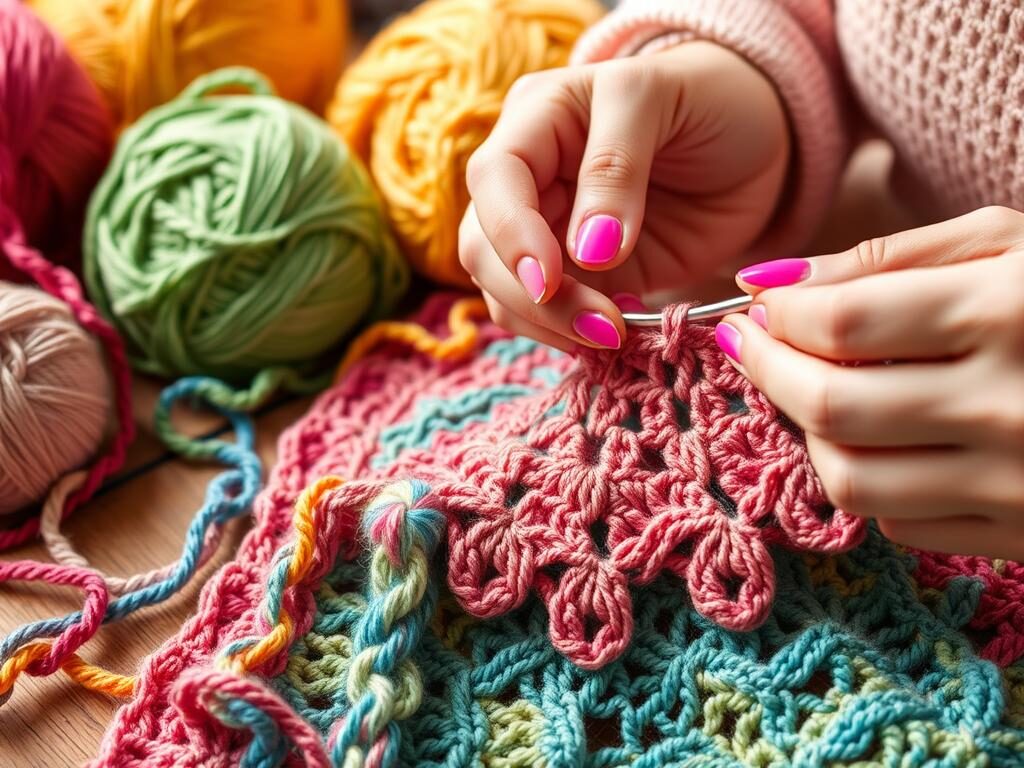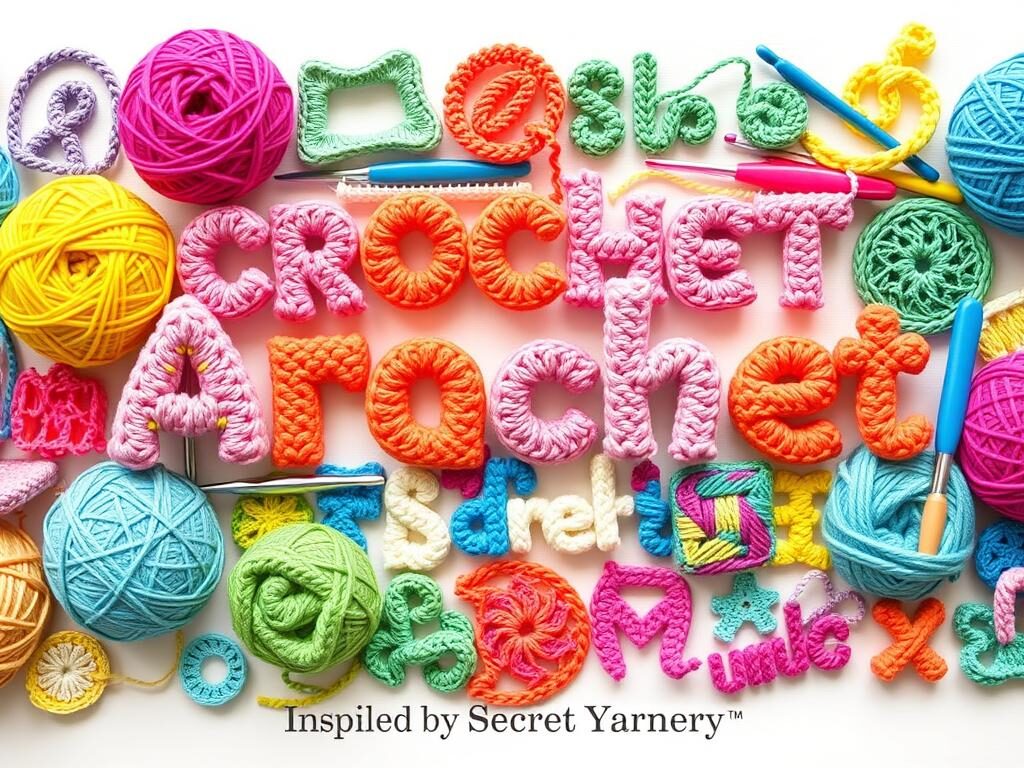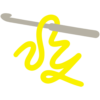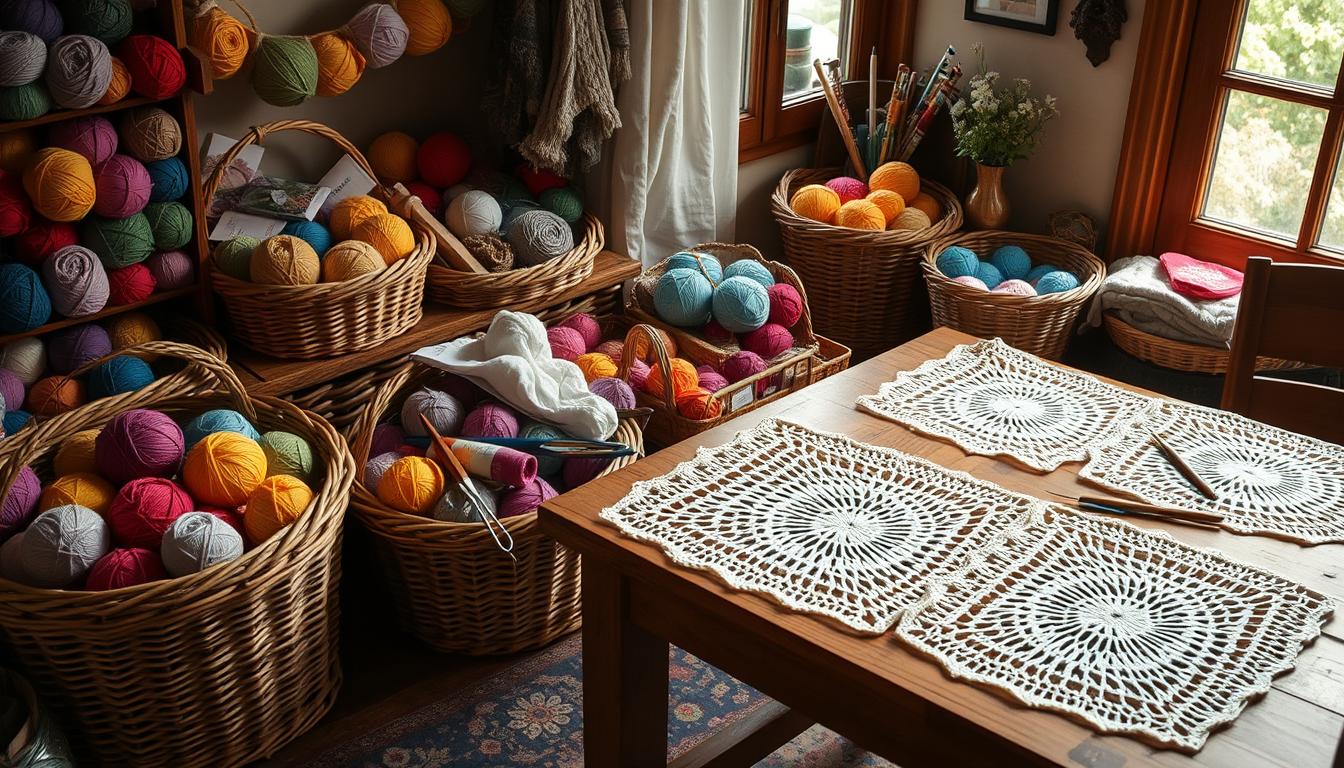Ultimate Beginner’s Guide to Learning Crochet
I’ve always loved crochet. The way the hook moves through yarn, creating a beautiful fabric, is amazing. I’m excited to share this with you in our ultimate beginner’s guide.
Crochet is more than just a craft; it’s a soothing and fulfilling art form that opens up a world of creativity and self-expression. If you’ve ever watched someone skillfully maneuver a hook and yarn, or perhaps admired a handmade scarf or cozy blanket, you might find yourself intrigued and eager to start your own crochet journey. In this ultimate beginner’s guide to learning crochet, we’ll dive into the essentials you need to know to confidently learn to crochet. Whether you’re dreaming of crafting stunning crochet garments to wear or creating charming crochet accessories to gift to loved ones, this guide will equip you with the fundamental skills and knowledge to bring your ideas to life. So, grab your yarn and hook, and let’s embark on this exciting adventure together!
If you’re new to crochet or have tried it before, this guide is for you. We’ll cover everything from picking the right yarn and hook to learning basic stitches. You’ll be ready to start any crochet project you like.
Key Takeaways
- Discover the basics of crochet, including how to hold the hook and yarn, make a slip knot, and work the chain stitch.
- Learn the most essential crochet stitches, such as single crochet, half double crochet, and double crochet.
- Gain an understanding of reading crochet patterns and deciphering common abbreviations.
- Build your skills and confidence through guided practice, including tips for working a crochet swatch.
- Find inspiration for beginner-friendly crochet projects and explore where your new skills can take you.
Let’s start our crochet journey together! Whether you want to make cozy accessories, beautiful home decor, or clothes, we’ve got you covered. Get ready for a fun crafting adventure.
Getting Started
Essential Crochet Supplies
To start crocheting, you need a few basic things. First, you’ll need a crochet hook and some yarn. Hooks come in different sizes and materials like metal, plastic, bamboo, and wood. Beginners often find a medium-sized ergonomic hook, like a G6 or H8, helpful.
You might also want scissors, yarn needles, stitch markers, and a measuring tape. These tools can make your crochet work easier.
Choosing the Right Yarn and Hook
For yarn, choose a medium-weight (number 4) acrylic, wool, or cotton. It should have a smooth texture. Dark or multicolored yarns can be tricky for beginners.
Check the yarn label for the recommended hook size. Start with a hook that matches that size. Try different materials to see what feels best in your hand. The right hook size for size 4 yarn is 5.5mm or size I-9.
Crochet offers many yarns and hooks to try. As you get better, you can explore different weights and fibers. For now, stick with a medium-weight yarn and a hook that feels natural.
“A common recommendation is to start with yarn sizes 4 and up when beginning crochet projects.”
Getting started is all about having the right tools. With the right hook and yarn, you’ll be ready to make beautiful projects.
Crochet Fundamentals
Learning the basic crochet techniques is key to making beautiful projects. We’ll cover how to hold the crochet hook and yarn correctly. This will help you start your crochet journey right.
How to Hold the Crochet Hook
There are two main ways to hold the crochet hook. You can use the pencil grip or the knife grip. The pencil grip is when you hold the hook like a pencil, between your thumb and index finger. The knife grip is when you place your hand over the hook, holding it between your thumb and index finger.
Try both grips to see which one feels better for you. It’s important to find a grip that feels natural and comfortable.
How to Hold the Yarn
To hold the yarn, wrap it around your non-dominant hand’s fingers. Place the yarn over your pinky, under your third and middle fingers, and over your index finger. Adjust the tension by squeezing your fingers together more or less.
Keeping the yarn tension consistent is key for even stitches.
Making a Slip Knot
To start your crochet project, make a slip knot. This will be the first loop on your crochet hook. Make a loop with the yarn, leaving a short tail.
Then, bring the tail over the loop and insert it into the loop from underneath. Pull the tail to tighten the knot. The slip knot is the base of your crochet project.
“Crochet is a craft technique that involves using a hooked needle to create fabric by interlocking loops of yarn or thread.”
Mastering the Chain Stitch
Crocheting a chain stitch might seem hard at first. But, it’s the key start for any crochet project. The chain stitch is the base, making your work sturdy. It’s a basic stitch for beginners, essential for your crochet skills.
The chain stitch is vital for many crochet projects. It’s used in clothes, accessories, homewares, and amigurumi. It’s called the Foundation Chain, the base for other stitches. In patterns, it’s written as “ch” followed by a number.
To start a chain stitch, make a slip knot on your hook. This is the first step. Hold the hook in one hand and the yarn in the other. Yarn over and pull through the loop on your hook. Keep doing this until you have the number of stitches needed.
Keeping your tension even is important when crocheting chains. Don’t make your stitches too loose or tight. This will help your project look good. Practice to get even, consistent chain stitches.
Learning the chain stitch is a big step in your crochet journey. It helps you learn more complex stitches and patterns. With patience and practice, you’ll make beautiful crochet pieces, starting with a solid foundation chain.
Working Into the Chain
Crocheting into the first row can be tricky for beginners. It’s important to keep your crochet tension even and know where to put your hook. Here are some tips to help you get it right and make a smooth first row.
Tips for Crocheting Into the First Row
- Use a slightly larger hook size than the one for your yarn. This makes the crochet stitches in the first row easier to manage.
- Mark the first stitch of each row with a stitch marker or scrap of yarn. This helps you know where to start the next row.
- Count your stitches carefully to keep the correct stitch count in the row.
- Take your time and don’t get discouraged. With practice, working into the chain will get easier.
Remember, finding the right crochet tension takes time. Be patient and keep practicing. Your skills will improve with each project.

“Consistent tension is the foundation of beautiful crochet. Don’t be afraid to try different ways of holding the yarn until you find what feels most comfortable.”
By following these tips and paying attention to your crochet tension, you’ll create beautiful first rows. These will help your project look great from start to finish.
learn to crochet
Crochet is a fun craft that lets you make many things, like cozy blankets and fancy lace. If you’re new to crochet, learning the basic stitches is key. We’ll cover three important stitches: the single crochet (SC), the half double crochet (HDC), and the double crochet (DC).
Single Crochet Stitch
The single crochet (SC) stitch is very useful and easy to learn. To do a single crochet, put your hook in the stitch you want, then yarn over. Pull the yarn through the stitch.
Next, yarn over again and pull through the two loops on your hook. Keep doing this for each stitch in the row to finish a single crochet row.
Half Double Crochet Stitch
The half double crochet (HDC) stitch is also very important. To make a half double crochet, yarn over, then put your hook in the stitch you want. Yarn over again and pull through one loop.
Then, yarn over and pull through all three loops on your hook. Keep making half double crochets for each stitch in the row.
Double Crochet Stitch
The double crochet (DC) stitch is taller than the single crochet or half double crochet. To start, yarn over, then put your hook in the stitch you want. Yarn over again and pull through one loop.
Yarn over and pull through two loops, then yarn over and pull through the last two loops. Keep doing this for each stitch in the row.
Learning these basic stitches will help you start many crochet projects. With practice and patience, you’ll get better and more confident.
Reading Crochet Patterns
Crochet patterns are key to making beautiful handmade items. But, they can be tricky for beginners to read. With some practice, you’ll get the hang of it quickly.
Understanding Crochet Abbreviations
Crochet patterns use short codes for stitch instructions. You’ll see abbreviations like:
- ch – chain
- sc – single crochet
- hdc – half double crochet
- dc – double crochet
- sl st – slip stitch
Learn these crochet abbreviations and their stitches. This will help you follow crochet patterns easily. You can also find detailed lists of crochet terms and abbreviations online, like the Craft Yarn Council’s Crochet Abbreviations Master List.
| Abbreviation | Stitch |
|---|---|
| ch | Chain |
| sl st | Slip Stitch |
| sc | Single Crochet |
| hdc | Half Double Crochet |
| dc | Double Crochet |
| tr | Triple (Treble) Crochet |

By learning common crochet pattern reading abbreviations and terms, you’ll be ready to tackle your next crochet project.
Building Confidence with Practice
As a beginner crocheter, practicing regularly is key to building confidence and improving skills. Working on a simple crochet swatch helps refine your technique. It also gives you insights into your tension and gauge.
Working a Swatch
Begin by chaining 21 stitches and then do a row of single crochets. Next, work rows of half double crochets and double crochets. This practice helps you master basic stitches and get used to hook placement.
- Consistent daily crochet practice is more beneficial than practicing once a week. Aim for 30 minutes to an hour of crochet practice per day.
- Regular crochet practice builds muscle memory, making new techniques easier to learn over time.
- The time it takes to master new crochet skills varies, so be patient and keep practicing.
Take time to examine your finished crochet swatch carefully. This helps you spot and fix any tension or gauge problems. Understanding your crochet tension and gauge ensures your projects look great.
“The more you practice, the better you get. Crochet is a skill that takes time to develop, but with dedication and an open mind, you can become a confident crocheter.”
Learning crochet is a journey, and mistakes are part of it. With regular crochet practice and a positive attitude, you’ll soon become skilled at crocheting.
Finding Inspiration and Beginner Projects
Once you’ve learned the basic crochet stitches, a world of crochet inspiration and beginner crochet projects opens up. Look online for crochet blogs, pattern databases, and social media. There, you’ll find many easy crochet patterns to help you grow your skills and confidence.
Begin by checking out pattern collections with simple stitches and easy-to-use yarns. Start with projects like scarves, hats, and blankets. These projects let you use your new skills in a fun and practical way. As you get better, you can try more complex designs and techniques.
The “Beginner’s Guide to Crochet: 20 projects for Beginners” by Sarah Shrimpton is a great resource. It teaches you crochet step by step with various beginner crochet projects. You’ll learn to make cozy blankets and cute animals like bears and unicorns.
Don’t forget to explore your local crochet community. Look for in-person classes at yarn stores or craft schools. These classes let you learn from experts and meet other crocheters. Also, attending crochet-focused events like craft fairs can inspire you and help you improve.
Enjoy the journey of beginner crochet projects and let your creativity shine. Making hats, scarves, or amigurumi toys is incredibly rewarding. As you get better, your love for crochet will grow.
Troubleshooting and Tips
Crochet is a rewarding craft, but it comes with its own set of challenges. Beginners often struggle with losing or gaining stitches, uneven tension, or wrong stitch placement. Don’t worry, these issues can be fixed with patience and the right techniques.
Common Mistakes and How to Fix Them
One common problem is uneven tension. Try adjusting how you hold the yarn or use a different hook size. Also, regularly check your stitch count to catch any mistakes early.
Turning chains can also be tricky. Make sure to follow the pattern instructions and practice until you get it right. Paying attention to where you insert your hook can prevent uneven edges or gaps.
Mistakes are a normal part of learning. If you make a mistake, take a break, look at your work, and check your pattern or tutorial. With crochet troubleshooting tips, you can fix any crochet mistakes.
“Crochet is a journey, and mistakes are just opportunities to learn and grow. Don’t be too hard on yourself – embrace the process and enjoy the ride.”
As you keep practicing, you’ll get better at solving crochet problem-solving challenges. The more you crochet, the more you’ll learn to fix any crochet troubleshooting issues that come up.
Conclusion
This crochet beginner guide has given you the basics to start crocheting. You now know how to pick the right tools and stitches. You’re ready to make beautiful crochet projects.
Don’t forget to practice often. Try out different patterns and materials. And remember, mistakes are part of learning. With hard work and patience, you’ll get better fast.
Keep looking for new crochet resources. There’s no one way to crochet. Let your style show and enjoy the process. The crochet community is full of helpful and inspiring people.
Stay connected and always look for new challenges. Most importantly, have fun making your own creations.
I’m excited to see where your crochet beginner guide journey goes. Keep exploring and enjoying the art of crochet. Happy crocheting!
FAQ
What essential supplies do I need to start crocheting?
To start crocheting, you need a crochet hook and yarn. Hooks come in different sizes and materials like metal, plastic, bamboo, and wood. Choose a hook size that matches the yarn weight you’re using.
Beginners should use a medium-sized ergonomic hook (G6 or H8). Also, pick a worsted-weight acrylic, wool, or cotton yarn in a light color. Tools like scissors, yarn needles, stitch markers, and a measuring tape are also helpful.
How do I hold the crochet hook and yarn?
There are two ways to hold the crochet hook: the pencil grip and the knife grip. For the pencil grip, hold the hook like a pencil between your thumb and index finger. For the knife grip, place your hand over the hook, grasping it between your thumb and index finger.
To hold the yarn, loop it through your non-dominant hand’s fingers. Pass the yarn over your pinky, under your third and middle fingers, and over your index finger.
How do I make a slip knot to start my crochet project?
To make a slip knot, create a loop with the yarn, leaving a short tail. Then, bring the tail over the loop and insert it into the loop from underneath. Pull the tail to tighten the knot.
The slip knot is the start of your crochet project.
What are the basic crochet stitches I should learn?
The three basic crochet stitches are the single crochet (SC), half double crochet (HDC), and double crochet (DC). To do a single crochet, insert your hook into a stitch, yarn over, and pull the yarn through the stitch.
Then, yarn over and pull the yarn through the two loops on your hook. For a half double crochet, yarn over, insert your hook into a stitch, yarn over, and pull the yarn through one loop.
Yarn over and pull the yarn through all three loops on your hook. To work a double crochet, yarn over, insert your hook into a stitch, yarn over, and pull the yarn through one loop. Yarn over and pull the yarn through two loops, then yarn over and pull through the final two loops.
How do I read and follow a crochet pattern?
Crochet patterns use abbreviations to quickly give stitch instructions. Common abbreviations include ch (chain), sc (single crochet), hdc (half double crochet), dc (double crochet), and sl st (slip stitch). Knowing these abbreviations and their stitches helps you follow patterns easily.
How can I build my confidence as a beginner crocheter?
Practicing by making a swatch is a great way to build confidence. Start by chaining 21 stitches, then work a row of single crochets. Follow with rows of half double crochets and double crochets.
This practice helps you get familiar with the basic stitches. Studying your finished swatch can also help you spot and fix tension issues.
Where can I find inspiration and beginner-friendly crochet projects?
Once you’ve learned the basic stitches, start looking for beginner-friendly projects. Check online pattern databases, crochet blogs, and social media for ideas. Look for patterns that use simple stitches and easy yarn.
As you get more confident, you can try more complex projects like scarves, hats, and blankets.
What are some common crochet mistakes and how can I fix them?
Common mistakes include losing or gaining stitches, uneven tension, and wrong stitch placement. If you make a mistake, don’t worry. Carefully check your work, count your stitches, and refer to your pattern or tutorial.
With patience and practice, you can identify and fix these mistakes.
Source Links
- Learn how to crochet. FREE ultimate beginner’s guide to crochet – https://crochetinthesun.com/howtocrochet/
- How to Crochet for Beginners: A Complete Guide – https://sarahmaker.com/how-to-crochet/
- How to Crochet: A Complete Guide for Beginners- Easy Crochet Patterns – https://easycrochet.com/crochet-for-beginners/
- Learn How to Crochet Right-Handed: A Beginner’s Course! – https://www.mooglyblog.com/learn-how-to-crochet/
- How to crochet – For absolute beginners – https://hopelesslydevotedcrochet.com/how-to-crochet-for-absolute-beginners/
- How to Crochet for Beginners – https://www.lionbrand.com/pages/how-to-crochet?srsltid=AfmBOoo_EbQ7CzOHmF-Lc2fY4gEHtQBMUJoNGui_FMpAEfTc6ONwVJzs
- How to Crochet for Beginners – https://www.thesprucecrafts.com/how-to-crochet-for-beginners-979092
- How to crochet a chain – Cilla Crochets – https://www.cillacrochets.com/crochet-tutorials/how-to-crochet-a-chain
- How to Crochet the Chain Stitch – With Video Tutorial – https://ameliamakes.com/how-to-crochet-the-chain-stitch-beginners/
- How to crochet into chains two ways – Dora Does – https://doradoes.co.uk/2022/09/28/how-to-crochet-into-chains-at-the-start-and-in-the-middle-of-a-project/
- How to Start a Crochet Chain – https://www.patchworkposse.com/start-crochet-chain/
- CAL: How to Start with a Chain and a Single Crochet – https://www.1dogwoof.com/cal-how-to-start-with-chain-and-single/
- How to Crochet for Beginners – https://www.lionbrand.com/pages/how-to-crochet?srsltid=AfmBOoox14Bu-Yt_sThHfFhT0iPn_AMIshJvCZIqEDFidp7YAML8LPO-
- Learn How to Crochet [Step-By-Step Video Tutorial for Beginners] – https://tlycblog.com/learn-how-to-crochet-step-by-step-video-tutorial-for-beginners/
- How to Read a Crochet Pattern – https://www.craftyarncouncil.com/standards/how-to-read-crochet-pattern
- How to Read Crochet Patterns for Total Beginners – https://tlycblog.com/how-to-read-crochet-patterns-for-total-beginners/
- How Do You Get Better at Crocheting – https://honouringme.blog/2024/04/25/how-do-you-get-better-at-crocheting/
- Get your Crojo back – Part 2: Increase Your Crochet Confidence – Indie Crochet Patterns – https://www.crochetwithmarybeth.com/how-to-increase-your-crochet-confidence/
- Finding your crochet inspiration – Cilla Crochets – https://www.cillacrochets.com/crochet-resources/finding-your-crochet-inspiration
- Crochet Projects for Beginners – My Summer of Crochet – Someone’s Mum – http://someonesmum.co.uk/2019/09/16/crochet-projects-for-beginners-my-summer-of-crochet/
- 17 Beginner Crochet Mistakes You Need To Avoid – Crochet Coach – https://crochetcoach.com/beginner-crochet/
- Common Crochet Gauge Problems – https://saltypearlcrochet.com/crochet-gauge-problems/
- Beginner Crochet Tips | Crochet.com – https://www.crochet.com/learning-center/crochet-tips-for-beginners
- What I’ve Learned My First Year of Crochet – https://www.sigonimacaroni.com/what-ive-learned-my-first-year-of-crochet/
- This Week I Learned…How To Crochet – Samrawit Ayele – https://samayele.com/this-week-i-learned-how-to-crochet/

